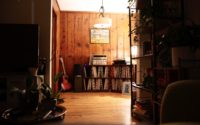Emahoy Tsegue-Maryam Guebrou’s “The Homeless Wanderer”
I never thought I’d discover one of my favorite albums during an acupuncture session. Most acupuncturists prefer white noise machines or soundscapes during treatment—music doesn’t work because it encourages a different kind of attention. But not so in New Orleans. As with so many aspects of life in that city, music infused Monica’s airy St. Claude shotgun. She preferred piano pieces or classic vocalists like Billie Holiday, whose brassy croon regularly emanated from the tinny speakers on her portable blue record player, and which fit the experience perfectly.
One rainy Saturday, while I reclined in the middle room and listened to the rain pattering playfully against the window, I heard the opening notes of the most enchanting piano piece. At first, it sounded like a tickle, as though the player’s fingers were joyfully tracing the instrument’s length. But as it went on, it developed a deeper meditative quality.

It turned out to be Ethiopian nun and pianist Emahoy Tsegue-Maryam Guebrou‘s song “The Homeless Wanderer.” Music truly finds you in the oddest places.
I eventually tracked down a copy of the record Monica played that day (the German LP, pictured left), which was only released in 2006 as part of a series spotlighting Ethiopian artists.
Guebrou, it turns out, was born in 1923 and lived in Ethiopia until Mussolini’s army invaded some 13 years later. She fled to Europe and could’ve attended the Royal Academy of Music in London, but for reasons she never clarified the opportunity fell through. “It was His willing,” she told documentary filmmaker Kate Molleson in 2017. “We can choose how to respond.”
Her response involved continuing to play music. But she made it her own. You could categorize her sound as classical, but it’s more meandering. You could call it jazz, but it’s more structured and thoughtful. It is entirely itself, full of insight and grit and sharply traced beauty. For a song composed by an Ethiopian nun to make it all the way to New Orleans seemed a sort of gift.
I have this preposterously under-studied theory that emotional contexts heavily—and heartily—shape the way we feel about certain songs. If you feel so inclined to throw a “duh” my way, I get it. But if you’re familiar with cognitive science, it makes sense. Memories have a stronger chance of lasting when emotions fuel the mechanisms that “record” them. Neuroscientist Marc Lewis explains, “If it doesn’t mean much, if it doesn’t induce feelings, it’s not going to capture your attention, and it’s not going to get recorded in synaptic structure.” The same applies to music. Emotional experiences sharpen—and shape—your response.
I love rainy days and I especially love rainy days in New Orleans, where moody skies and hushed streets create a melody unto themselves. Something about that backdrop set the stage for Guebrou: slanted rain falling against the room’s tall windows, dim light filtering through the lacy curtains. It was the kind of magic that prompts notice, that encourages you to think, as Vonnegut once said, “If this isn’t nice, what is.”
And it’s a magic that has yet to wear off. When I play Guebrou now, time slows. I feel my shoulders drop with the first few notes. The following songs build an escape from the everyday. Guebrou’s phrasing—those winding reflections—makes everything soften, rainy day or not.


